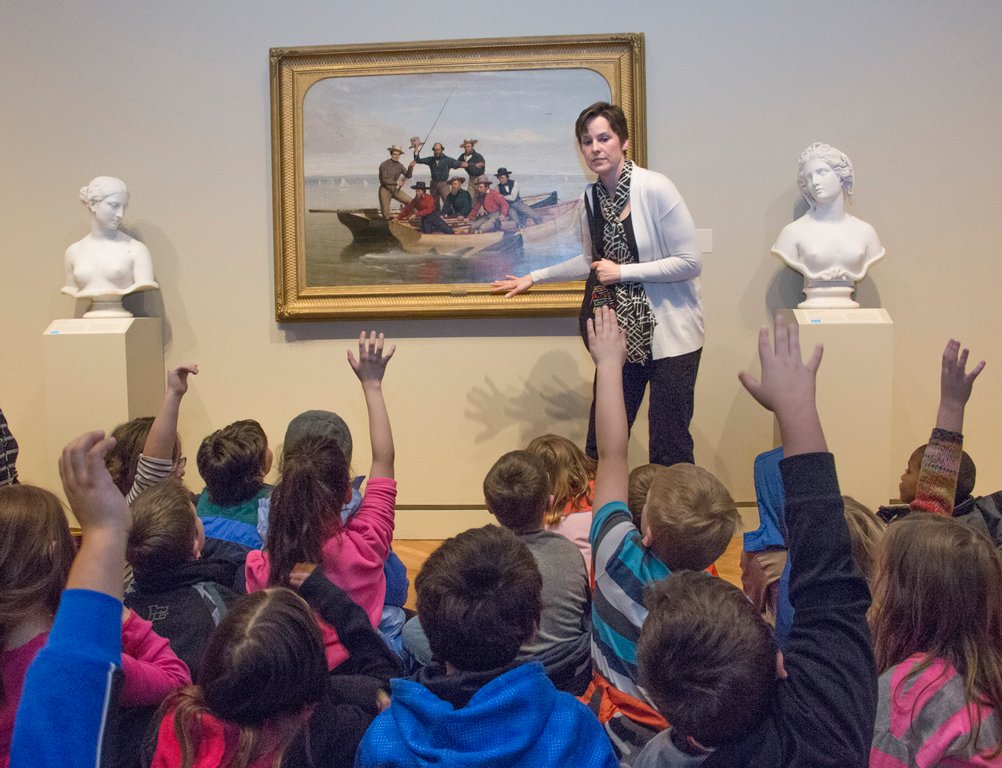Inquiry
On an inquiry-based tour, all visitors have an opportunity to observe, form opinions, and develop an understanding of the art. Inquiry teaching, or instruction through questions, encourages museum visitors to really look at and engage with artworks. Inquiry activates curiosity. Questions invite visitors to discover more about artworks, analyze artists’ intentions, examine their own responses and attitudes, and share with others. Questions spark curiosity and engagement. It is not enough to simply hear information about art; people remember best when they have helped to construct the meaning. Before moving to questions about the art, allow students some time to look at the art.
Being able to answer questions and talk about art empowers both children and adults. As a guide, you play the role of facilitator, and facilitation is a dynamic process. By asking questions and leading discussions on your tours, you involve visitors in the learning process. By encouraging visitors to generate their own ideas and construct meaning on their own, you help them develop skills they can use to become independent learners in the museum.
There are other good reasons to use inquiry on your tours. If you begin your tour with thoughtful open-ended questions, you learn a lot about your group—attitudinally, intellectually, visually, and verbally. The use of inquiry creates an atmosphere of trust because it demonstrates that you are genuinely interested in what the group thinks.
As mentioned in the section on Tour Preparation, participation encompasses more than voicing a response. While open-ended questions create opportunities for discussion, not all visitors will be comfortable with voicing their ideas, so inquiry inviting nonverbal participation (e.g., answering with thumbs up/down) also should be presented on the tour.
Scaffold questions
Inquiry will be most successful if you scaffold your questions on the tour, moving from simple to more complex questions. Begin with basic observation (description) questions or exercises that encourage visitors to look closely (e.g., Describe what you see, or What’s going on in this picture?).
Take multiple answers. Follow up on some responses with a question that asks students to back up their responses with evidence from the artwork itself (e.g., What about his expression makes you say he is sad? What do you see that makes you say that?). This can often be further followed up with a question that asks them to think about their explanations (e.g., Why might the artist have painted this way?). By scaffolding questions, you encourage tour participants to look, explain, and generate ideas.
To learn more about scaffolding as an instructional technique, see this link.
Wait time
We all process information at different rates. An inclusive tour builds in wait time, allowing students to look at the art and construct some meaning in response to the question asked. It’s good to remind ourselves of our own familiarity with the art, and how, when seeing it for the first time, we needed more time to visually understand it. Put yourself in the shoes of a first-time visitor. Wait until more than one or two students have their hands raised. Building in wait time allows for more students to participate, and it also helps prevent you from answering your own question if you tend to jump in when there is silence.
Accept multiple answers
If you encourage multiple answers with your open-ended questions, then leave enough time on your tour to hear from the students. Avoid shutting down the discussion after receiving one answer in order to convey one of your key ideas about the artwork.
Be active in facilitation, making an effort to hear from all in the group during the tour. Move away from any dominant classroom dynamic within the group, such as when two or three students continually participate in discussion.
Paraphrase
An important part of inquiry-based learning is actively demonstrating you heard and understood responses to questions. Paraphrase responses you receive to fuel more participation. Paraphrasing also allows all members of the group to hear the response and is a dynamic expression of your engagement with the group. It lets you make connections between observations from the visitors. For example, “So you feel that the man is sad, too, but you believe that he is sad because of the dark colors the artist used.” When paraphrasing, position yourself to the side of the art and face the group, so all can hear what you are saying.
